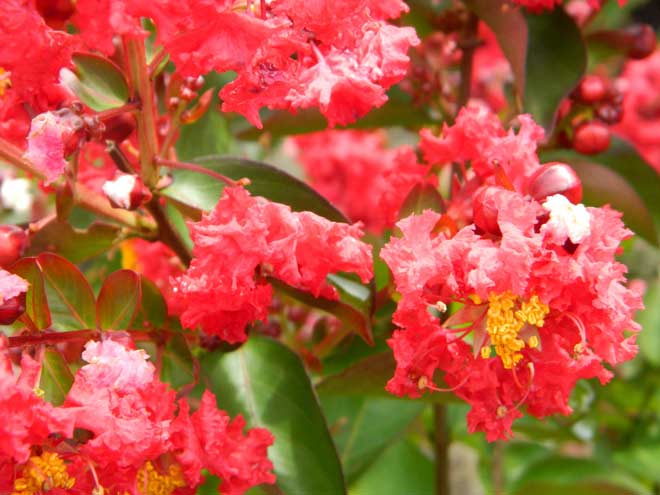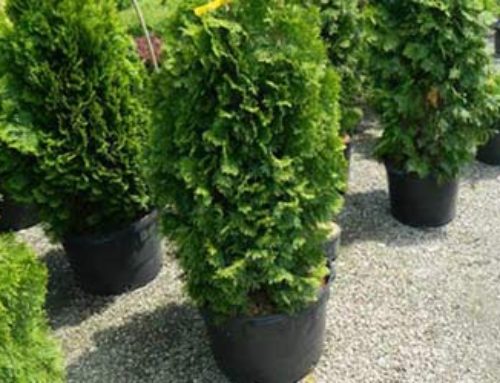
Landscape For All Seasons By Jane W. Edwards
Spring is the most popular time to design our home landscape and do most of the planting because we ourselves are anxious to get outdoors. Therefore, most of our yards are at their peak in the spring. At other times of the year our landscape may be more blasé, since we didn’t consider what our plants would look like other than when we chose them. Spring isn’t the only culprit—whichever season we choose to add a plant to our landscape is usually the peak season of its performance.
We achieve a highly desirable landscape if we garden year round, but few of us do that. Most of us prefer spring or fall because of the more enjoyable temperatures. We can alleviate the single-season landscape if we choose carefully the shrubs, trees, and flowers we put into our yard. Ask lots of questions of your Plant Professional; don’t choose a plant just because it looks spectacular today. Ask what it looks like other times of the year. Many, many plants have appeal in several seasons, some in all seasons.
One of the first to come to mind is the Japanese maple. These small trees are spectacular in spring as their bright foliage is bursting forth. Many of the varieties are red leafed such as Bloodgood, or Trompenburg-. Several are variegated like Butterflies or Waterfall. They prefer some afternoon shade during our summers. Summer finds most maples noticed for their colorful foliage and characteristic shape. As fall weather cools, Japanese Maples will show fresh bright foliage on the tips and most varieties produce a brilliant colorful fall show before their leaves fall. Winter’s starkness makes you notice the unusual Oriental shape of these Maples. Some will droop, others crisscross gracefully as they reach skyward, and all have fine textured little branches giving the tree a thick appearance in winter. Most of the Japanese Maples have a smooth, soft looking bark; while Sango Kaku sports a bright red winter bark, the center of attraction in the winter garden.
There are many shiny leafed evergreens, which give our landscape definition since they always have foliage and substance regardless of the season. These evergreens vary significantly. While the hollies usually have small spring flowers and an abundance of red berries in the winter: the camellias will abound with flowers either in the fall or spring depending on the species. One of my favorites, which blooms in late November, is Yuletide —a bright red flower with a shiny yellow center. Another shiny leaf plant is Cleyera Japonica—having small white spring blooms, pink new growth, and deep burgundy foliage in the cold of winter.
Don’t forget the yellow foliaged plants like Gold Mop Cypress or Yellow Ribbon Arborvitae. Their bright yellow foliage is a showstopper all year long. Other needle foliage plants are special for their ferny, wispy look. Many of the conifers have blue gray foliage, or their needles may turn red in winter. Color comes in all shapes and hues.
Many of the newest plants are variegated or have two-toned foliages. There is a Mariesii Variegated Hydrangea whose summer 6 inch green and white leaves are more spectacular than its blue blossoms, but without a lot of show in the colder months. The new Confetti Abelia keeps its green and white small leaves year round but is covered during the summer and fall with small white trumpet shaped flowers. Confetti has pink new growth and is one of the hottest new plants in the marketplace. Also appearing this year is a variegated Willow called Hakuro Nishiki with green, pink, and white leaves. This Willow is a stunning colored plant with a topiary shape. To keep the foliage colorful, you do have to prune it often, not too hard for all the beauty it gives.
There are so many plants with year round attraction that you wonder why we choose to use many that are just green and “ordinary”. Have you seen a fabric with so many colors and patterns that it is unappealing? So can your landscape be. We need the soft green background to make our year round colors really stand out and be noticed. Can we have too much color? Possibly, unless we give the yard a subtle green background to tone it down and make the colors more harmonious.
So choose your plants to be beautiful all year, not just the day you see them at their peak. Make plants audition for a spot in your yard. If its short performance doesn’t leave you spellbound for the rest of the year, then a plant should entertain you all year round-maybe more subtle some days than other, but never just disappearing. Make your plants perform year round for a beautiful, lasting, impressionable landscape.
– Jane W. Edwards of Turtle Creek Nursery


